Emission Ratios and Source Identification of VOCs in Moscow in 2019–2020
Abstract
:1. Introduction
2. Materials and Methods
2.1. Observation Site and Instruments
2.2. Meteorology
3. Results
3.1. Ozone Formation Potential of VOCs
3.2. Annual Variations in CO and VOCs in Moscow
3.3. Diurnal Variations in CO and VOCs
3.4. Determination of VOC Emission Ratios
3.5. Source Identification of VOC Emissions
4. Conclusions
Author Contributions
Funding
Institutional Review Board Statement
Informed Consent Statement
Data Availability Statement
Acknowledgments
Conflicts of Interest
References
- Schnell, R.C.; Oltmans, S.J.; Neely, R.R.; Endres, M.S.; Molenar, J.V.; White, A.B. Rapid photochemical production of ozone at high concentrations in a rural site during winter. Nat. Geosci. 2009, 2, 120–122. [Google Scholar] [CrossRef]
- Agyei, T.; Juráň, S.; Edwards-Jonášová, M.; Fischer, M.; Švik, M.; Komínková, K.; Ofori-Amanfo, K.K.; Marek, M.V.; Grace, J.; Urban, O. The Influence of Ozone on Net Ecosystem Production of a Ryegrass–Clover Mixture under Field Conditions. Atmosphere 2021, 12, 1629. [Google Scholar] [CrossRef]
- Berezina, E.; Moiseenko, K.; Skorokhod, A.; Pankratova, N.V.; Belikov, I.; Belousov, V.; Elansky, N.F. Impact of VOCs and NOx on Ozone Formation in Moscow. Atmosphere 2020, 11, 1262. [Google Scholar] [CrossRef]
- Millet, D.B.; Guenther, A.; Siegel, D.A.; Nelson, N.B.; Singh, H.B.; de Gouw, J.A.; Warneke, C.; Williams, J.; Eerdekens, G.; Sinha, V.; et al. Global atmospheric budget of acetaldehyde: 3-D model analysis and constraints from in-situ and satellite observations. Atmos. Chem. Phys. 2010, 10, 3405–3425. [Google Scholar] [CrossRef] [Green Version]
- Kim, S.-W.; McKeen, S.A.; Frost, G.J.; Lee, S.-H.; Trainer, M.; Richter, A.; Angevine, W.M.; Atlas, E.; Bianco, L.; Boersma, K.F.; et al. Evaluations of NOx and highly reactive VOC emission inventories in Texas and their implications for ozone plume simulations during the Texas Air Quality Study 2006. Atmos. Chem. Phys. 2011, 11, 11361–11386. [Google Scholar] [CrossRef] [Green Version]
- Coll, I.; Rousseau, C.; Barletta, B.; Meinardi, S.; Blake, D.R. Evaluation of an urban NMHC emission inventory by measure-ments and impact on CTM results. Atmos. Environ. 2010, 44, 3843–3855. [Google Scholar] [CrossRef] [Green Version]
- Baker, A.K.; Beyersdorf, A.J.; Doezema, L.A.; Katzenstein, A.; Meinardi, S.; Simpson, I.J.; Blake, D.R.; Rowland, F.S. Measurements of nonmethane hydrocarbons in 28 United States cities. Atmos. Environ. 2008, 42, 170–182. [Google Scholar] [CrossRef] [Green Version]
- Parrish, D.D.; Kuster, W.C.; Shao, M.; Kondo, Y.; Goldan, P.D.; de Gouw, J.A.; Koike, M.; Shirai, T. Comparison of air pollutant emissions among mega-cities. Atmos. Environ. 2009, 43, 6435–6441. [Google Scholar] [CrossRef]
- Velasco, E.; Lamb, B.; Pressley, S.; Allwine, E.; Westberg, H.; Jobson, B.T.; Alexander, M.; Prazeller, P.; Molina, L.; Molina, M. Flux measurements of volatile organic compounds from an urban landscape. Geophys. Res. Lett. 2005, 32, L20802. [Google Scholar] [CrossRef]
- Acton, W.J.F.; Huang, Z.; Davison, B.; Drysdale, W.S.; Fu, P.; Holloway, M.; Langford, B.; Lee, J.; Liu, Y.; Metzger, S.; et al. Surface–atmosphere fluxes of volatile organic compounds in Beijing. Atmos. Chem. Phys. 2020, 20, 15101–15125. [Google Scholar] [CrossRef]
- Vaughan, A.R.; Lee, J.D.; Shaw, M.D.; Misztal, P.K.; Metzger, S.; Vieno, M.; Davison, B.; Karl, T.G.; Carpenter, L.J.; Lewis, A.C.; et al. VOC emission rates over London and South East England obtained by airborne eddy covariance. Faraday Discuss. 2017, 200, 599–620. [Google Scholar] [CrossRef] [PubMed] [Green Version]
- Karl, T.; Misztal, P.K.; Jonsson, H.H.; Shertz, S.; Goldstein, A.H.; Guenther, A.B. Airborne Flux Measurements of BVOCs above Californian Oak Forests: Experimental Investigation of Surface and Entrainment Fluxes, OH Densities, and Damkцhler Numbers. J. Atmos. Sci. 2013, 70, 3277–3287. [Google Scholar] [CrossRef] [Green Version]
- Park, C.; Schade, G.W.; Boedeker, I. Flux measurements of volatile organic compounds by the relaxed eddy accumulation methodcombined with a GC-FID system in urban Houston, Texas. Atmos. Environ. 2010, 44, 2605–2614. [Google Scholar] [CrossRef]
- Martin, R.V.; Jacob, D.J.; Chance, K.; Kurosu, T.P.; Palmer, P.I.; Evans, M.J. Global inventory of nitrogen oxides emissions constrained by spacebased observations of NO2 columns. J. Geophys. Res. 2003, 108, 4537. [Google Scholar] [CrossRef] [Green Version]
- Lanz, V.A.; Hueglin, C.; Buchmann, B.; Hill, M.; Locher, R.; Staehelin, J.; Reimann, S. Receptor modeling of C2–C7 hydro-carbon sources at an urban background site in Zurich, Switzerland: Changes between 1993–1994 and 2005–2006. Atmos. Chem. Phys. 2008, 8, 2313–2332. [Google Scholar] [CrossRef] [Green Version]
- Gaimoz, C.; Sauvage, S.; Gros, V.; Herrmann, F.; Williams, J.; Locoge, N.; Perrussel, O.; Bonsang, B.; d’Argouges, O.; Sarda-Estиve, R.; et al. Volatile organic compounds sources in Paris in spring 2007. Part II: Source apportionment using positive matrix factorization. Environ. Chem. 2011, 8, 91–103. [Google Scholar] [CrossRef]
- Morino, Y.; Ohara, T.; Yokouchi, Y.; Ooki, A. Comprehensive source apportionment of volatile organic compounds using observational data, two receptor models, and an emission inventory in Tokyo metropolitan area. J. Geophys. Res. 2011, 116, D02311. [Google Scholar] [CrossRef] [Green Version]
- Warneke, C.; McKeen, S.A.; de Gouw, J.A.; Goldan, P.D.; Kuster, W.C.; Holloway, J.S.; Williams, E.J.; Lerner, B.M.; Parrish, D.D.; Trainer, M.; et al. Determination of urban volatile organic compound emission ratios and comparison with an emissions database. J. Geophys. Res. 2007, 112, D10S47. [Google Scholar] [CrossRef]
- McKeen, S.; Grell, G.; Peckham, S.; Wilczak, J.; Djalalova, I.; Hsie, E.-Y.; Frost, G.; Peischl, J.; Schwarz, J.; Spackman, R.; et al. An evaluation of real-time air quality forecasts and their urban emissions over eastern Texas during the summer of 2006 Second Texas Air Quality Study field study. J. Geophys. Res. 2009, 114, D00F11. [Google Scholar] [CrossRef] [Green Version]
- Borbon, A.; Gilman, J.B.; Kuster, W.C.; Grand, N.; Chevaillier, S.; Colomb, A.; Dolgorouky, C.; Gros, V.; Lopez, M.; Sarda-Esteve, R.; et al. Emission ratios of anthropogenic volatile organic compounds in northern mid-latitude megacities: Observations versus emission inventories in Los Angeles and Paris. J. Geophys. Res. Atmos. 2013, 118, 2041–2057. [Google Scholar] [CrossRef]
- Sahu, L.K.; Yadav, R.; Pal, D. Source identification of VOCs at an urban site of western India: Effect of marathon events and anthropogenic emissions. J. Geophys. Res. Atmos. 2016, 121, 2416–2433. [Google Scholar] [CrossRef] [Green Version]
- Andreae, M.O.; Merlet, P. Emission of trace gases and aerosols from biomass burning. Glob. Biogeochem. Cycles 2001, 15, 955–966. [Google Scholar] [CrossRef] [Green Version]
- Elansky, N.F.; Belikov, I.B.; Berezina, E.V. Atmospheric Composition over Northern Eurasia: The TROICA Experiments; Agrospas: Moscow, Russia, 2009; pp. 73–90. [Google Scholar]
- Berezina, E.; Moiseenko, K.; Skorokhod, A.; Elansky, N.; Belikov, I.; Pankratova, N. Isoprene and monoterpenes over Russia and their impacts in tropospheric ozone formation. Geogr. Environ. Sustain. 2019, 12, 63–74. [Google Scholar] [CrossRef]
- de Gouw, J.; Warneke, C. Measurements of volatile organic compounds in the Earth’s atmosphere using proton-transferreaction mass spectrometry. Mass Spectrom. Rev. 2007, 26, 223–257. [Google Scholar] [CrossRef] [PubMed]
- Taipale, R.; Ruuskanen, T.M.; Rinne, J.; Kajos, M.K.; Hakola, H.; Pohja, T.; Kulmala, M. Technical Note: Quantitative long-term measurements of VOC concentrations by PTR-MS—Measurement, calibration, and volume mixing ratio calculation methods. Atmos. Chem. Phys. 2008, 8, 6681–6698. [Google Scholar] [CrossRef] [Green Version]
- Karl, T.G.; Spirig, C.; Rinne, J.; Stroud, C.; Prevost, P.; Greenberg, J.; Fall, R.; Guenther, A. Virtual disjunct eddy covariance measurements of organic compound fluxes from a subalpine forest using proton transfer reaction mass spectrometry. Atmos. Chem. Phys. 2002, 2, 279–291. [Google Scholar] [CrossRef] [Green Version]
- Vlasenko, A.; Slowik, J.G.; Bottenheim, J.W.; Brickell, P.C.; Chang, R.W.; Macdonald, A.M.; Shantz, N.C.; Sjostedt, S.J.; Wiebe, H.A.; Leaitch, W.R.; et al. Measurements of VOCs by proton transfer reaction mass spectrometry at a rural Ontario site: Sources and correlation to aerosol composition. J. Geophys. Res. 2009, 114, D21305. [Google Scholar] [CrossRef] [Green Version]
- Karl, T.; Hansel, A.; Cappellin, L.; Kaser, L.; Herdlinger-Blatt, I.; Jud, W. Selective measurements of isoprene and 2-methyl-3-buten-2-ol based on NO+ ionization mass spectrometry. Atmos. Chem. Phys. 2012, 12, 11877–11884. [Google Scholar] [CrossRef] [Green Version]
- Jordan, C.; Fitz, E.; Hagan, T.; Sive, B.; Frinak, E.; Haase, K.; Cottrell, L.; Buckley, S.; Talbot, R. Long-term study of VOCs measured with PTR-MS at a rural site in New Hampshire with urban influences. Atmos. Chem. Phys. 2009, 9, 4677–4697. [Google Scholar] [CrossRef] [Green Version]
- Valach, A.C.; Langford, B.; Nemitz, E.; MacKenzie, A.R.; Hewitt, C.N. Concentrations of selected volatile organic compounds at kerbside and background sites in central London. Atmos. Environ. 2014, 95, 456–467. [Google Scholar] [CrossRef] [Green Version]
- Carter, W.P.L. Development of the SAPRC-07 Chemical Mechanism and Updated Ozone Reactivity Scales; Final Report to the California Air Resources Board Contract No. 03-318; California Air Resources Board, Research Division: Sacramento, CA, USA, 2010. [Google Scholar]
- Holloway, T.; Levy, H.; Kasibhatla, P. Global distribution of carbon monoxide. J. Geophys. Res. 2000, 105, 12123–12147. [Google Scholar] [CrossRef]
- Derwent, R.G.; Simmonds, P.G.; Seuring, S.; Dimmer, C. Observation and interpretation of the seasonal cycles in the surface concentrations of ozone and carbon monoxide at mace head, Ireland from 1990 to 1994. Atmos. Environ. 1998, 32, 145–157. [Google Scholar] [CrossRef]
- Derwent, R.G.; Parrish, D.D.; Simmonds, P.G.; O’Doherty, S.J.; Spain, T.G. Seasonal cycles in baseline mixing ratios of a large number of trace gases at the Mace Head, Ireland atmospheric research station. Atmos. Environ. 2020, 233, 117531. [Google Scholar] [CrossRef]
- Pochanart, P.; Akimoto, H.; Kajii, Y.; Potemkin, V.M.; Khodzher, T.V. Regional background ozone and carbon monoxide varia-tions in remote Siberia/East Asia. J. Geophys. Res. 2003, 108, 4028. [Google Scholar] [CrossRef]
- Vasileva, A.V.; Moiseenko, K.B.; Mayer, J.-C.; Jürgens, N.; Panov, A.; Heimann, M.; Andreae, M.O. Assessment of the re-gional atmospheric impact of wildfire emissions based on CO observations at the ZOTTO tall tower station in central Siberia. J. Geophys. Res. 2011, 116, D07301. [Google Scholar] [CrossRef]
- Skorokhod, A.I.; Berezina, E.V.; Moiseenko, K.B.; Elansky, N.F.; Belikov, I.B. Benzene and toluene in the surface air of north-ern Eurasia from TROICA-12 campaign along the Trans-Siberian Railway. Atmos. Chem. Phys. 2017, 17, 5501–5514. [Google Scholar] [CrossRef] [Green Version]
- Tiwari, V.; Hanai, Y.; Masunaga, S. Ambient levels of volatile organic compounds in the vicinity of petrochemical industrial area of Yokohama, Japan. Air Qual. Atmos. Health 2010, 3, 65–75. [Google Scholar] [CrossRef] [Green Version]
- Shaw, M.D.; Lee, J.D.; Davison, B.; Vaughan, A.; Purvis, R.M.; Harvey, A.; Lewis, A.C.; Hewitt, C.N. Airborne determination of the temporospatial distribution of benzene, toluene, nitrogen oxides and ozone in the boundary layer across Greater London, UK. Atmos. Chem. Phys. 2015, 15, 5083–5097. [Google Scholar] [CrossRef] [Green Version]
- Carballo-Pat, C.G.; Cerуn-Bretуn, J.G.; Cerуn-Bretуn, R.M.; Ramнrez-Lara, E.; Aguilar-Ucбn, C.A.; Montalvo-Romero, C.; Guevara-Carriу, E.; Cуrdova-Quiroz, A.V.; Gamboa-Fernбndez, J.M.; Uc-Chi, M.P. Latest trends in Energy. Environment and Development. In Proceedings of the 7-th International Conference on Environmental and Geological Sciences and Engineering (EG’14), Salerno, Italy, 3–5 June 2014; pp. 132–140. [Google Scholar]
- Warneke, C.; van der Veen, C.; Luxembourg, S.; de Gouw, J.A.; Kok, A. Measurements of benzene and toluene in ambient air using proton-transfer-reaction mass spectrometry: Calibration humidity dependence and field intercomparison. Int. J. Mass Spectrom. 2001, 207, 167–182. [Google Scholar] [CrossRef]
- Brito, J.; Wurm, F.; Yáñez-Serrano, A.M.; de Assunção, J.V.; Godoy, J.M.; Artaxo, P. Vehicular emission ratios of VOCs in a megacity impacted by extensive ethanol use: Results of ambient measurements in São Paulo, Brazil. Environ. Sci. Technol. 2015, 49, 11381–11387. [Google Scholar] [CrossRef]
- Reimann, S.; Calanca, P.; Hofer, P. The anthropogenic contribution to isoprene concentrations in a rural atmosphere. Atmos. Environ. 2000, 34, 109–115. [Google Scholar] [CrossRef]
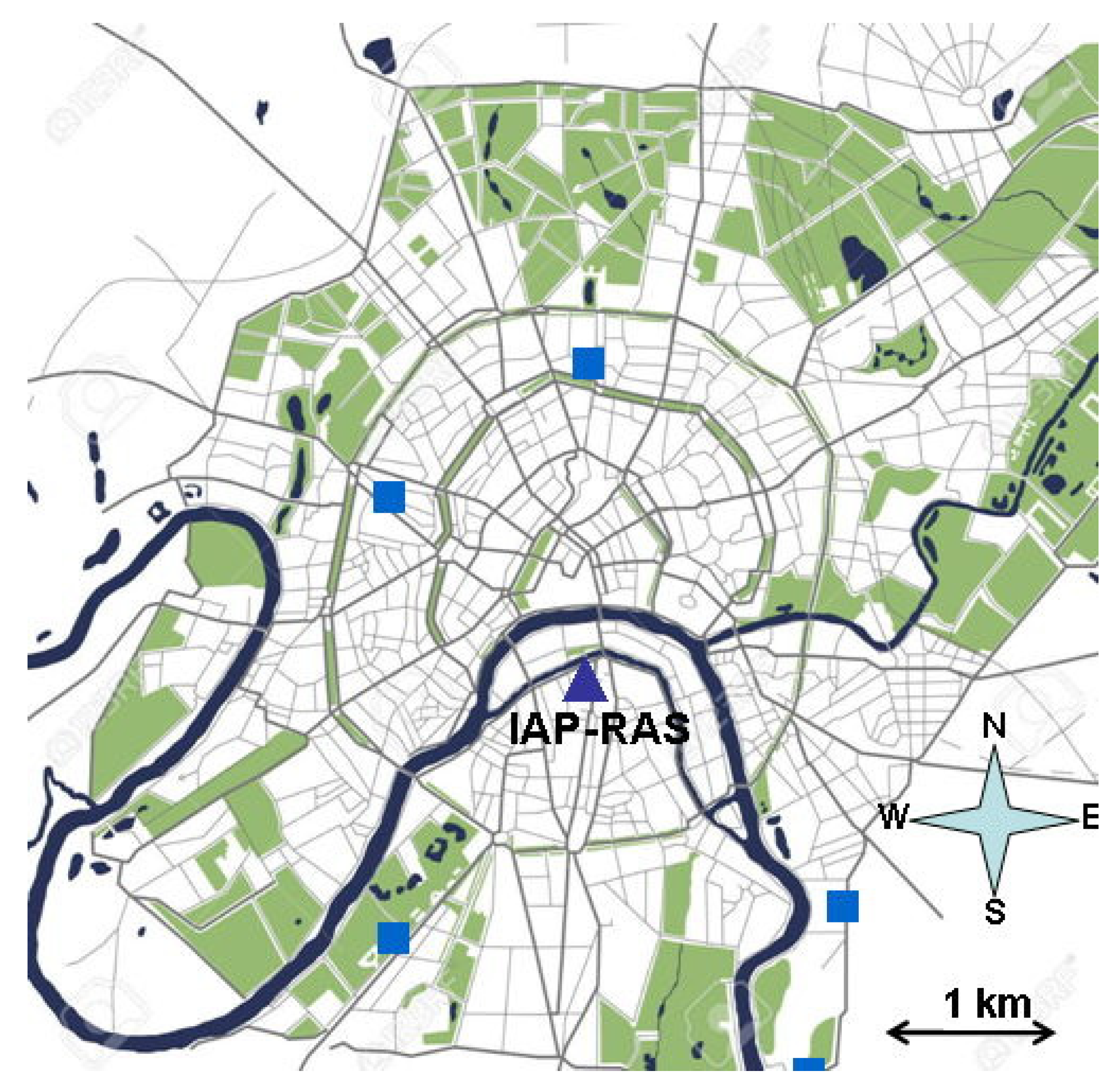
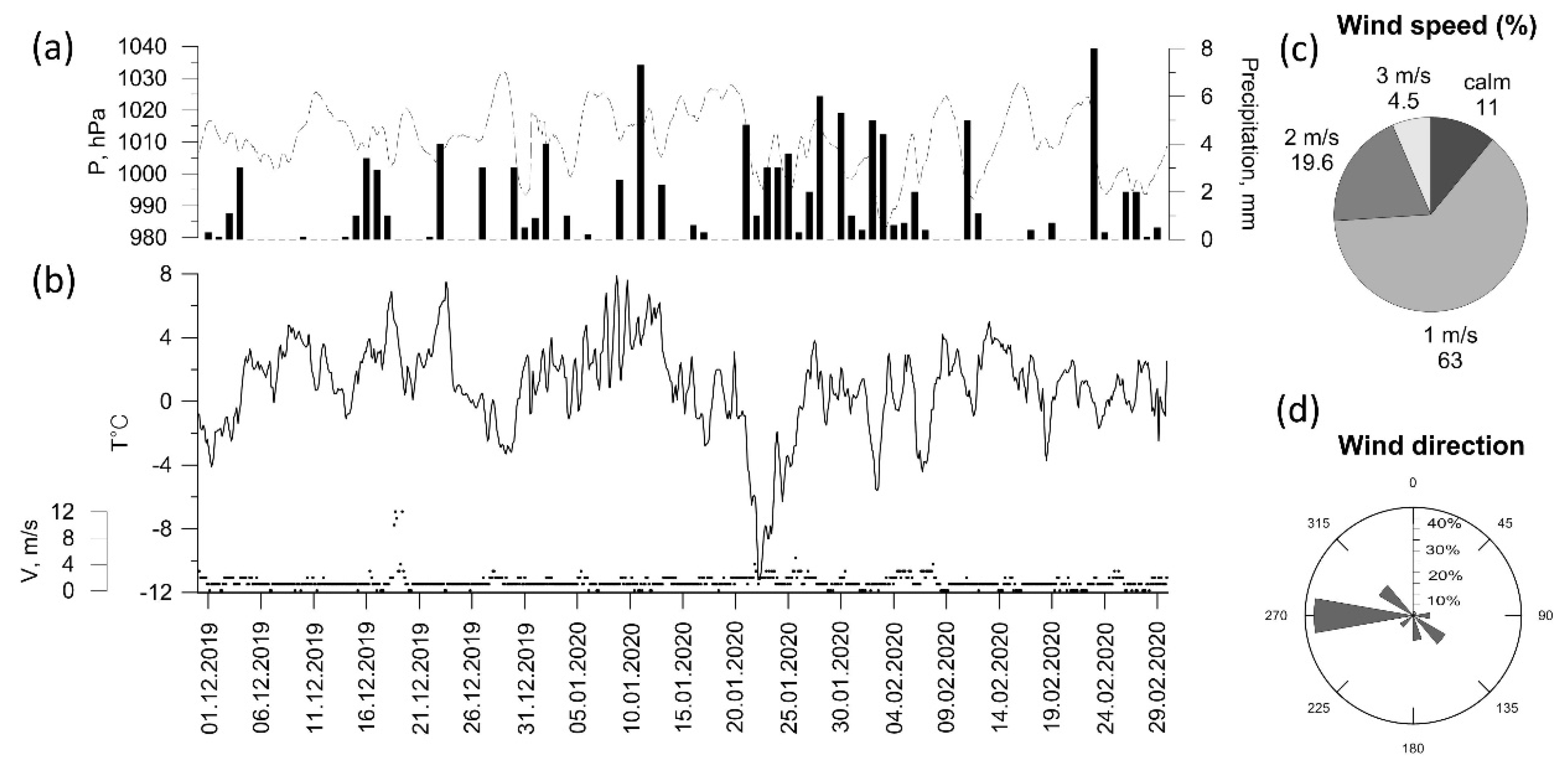
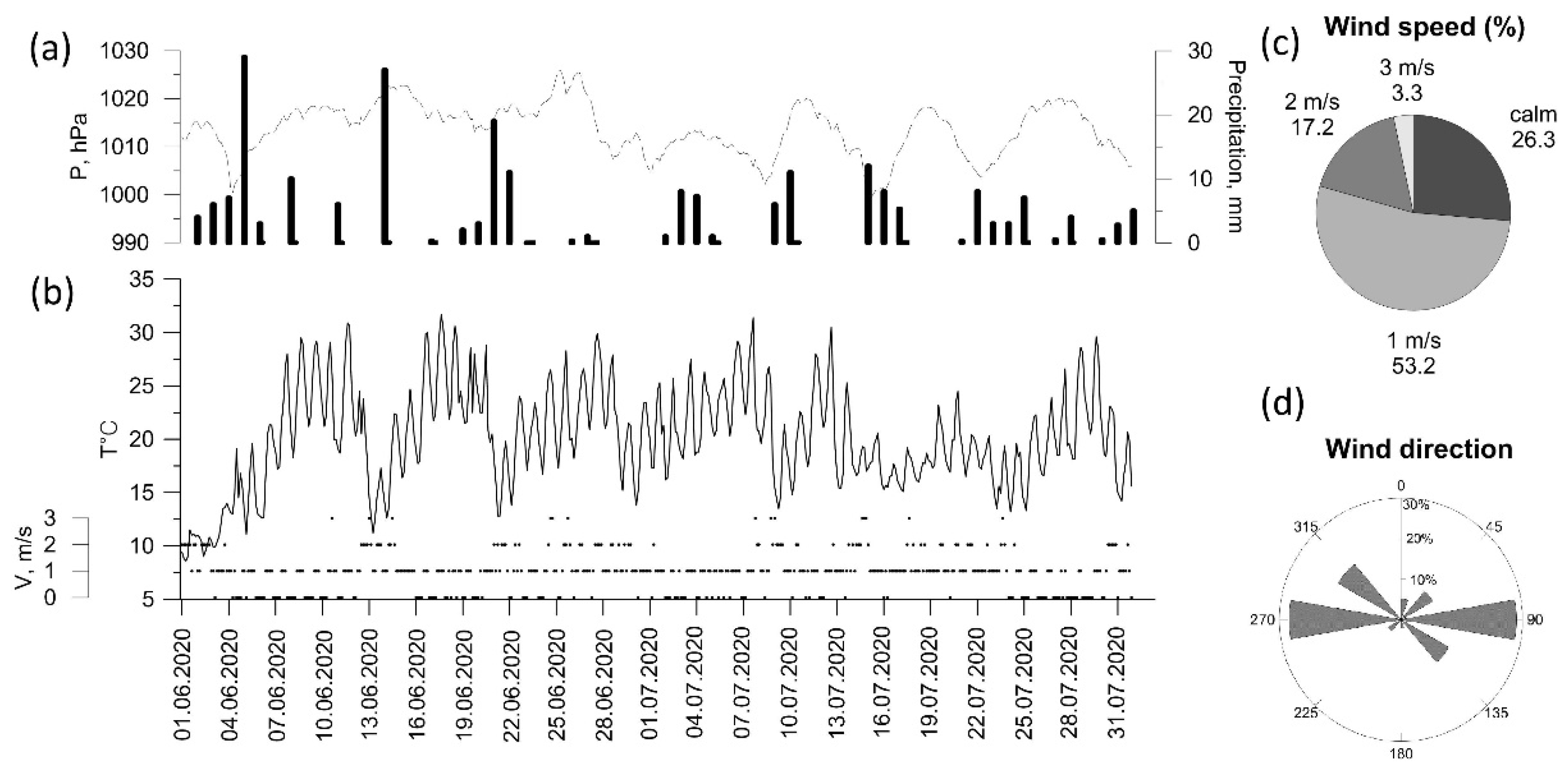
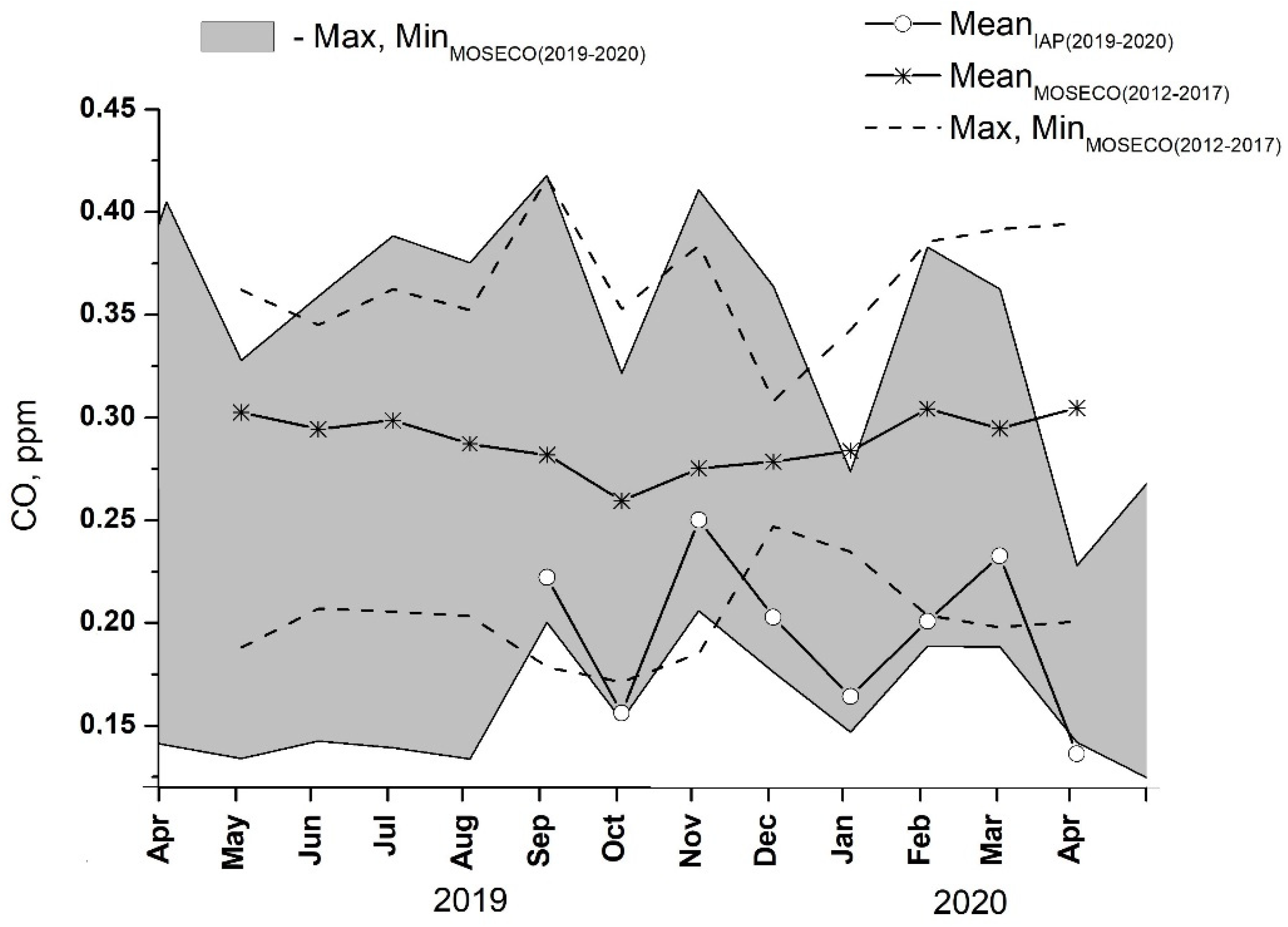
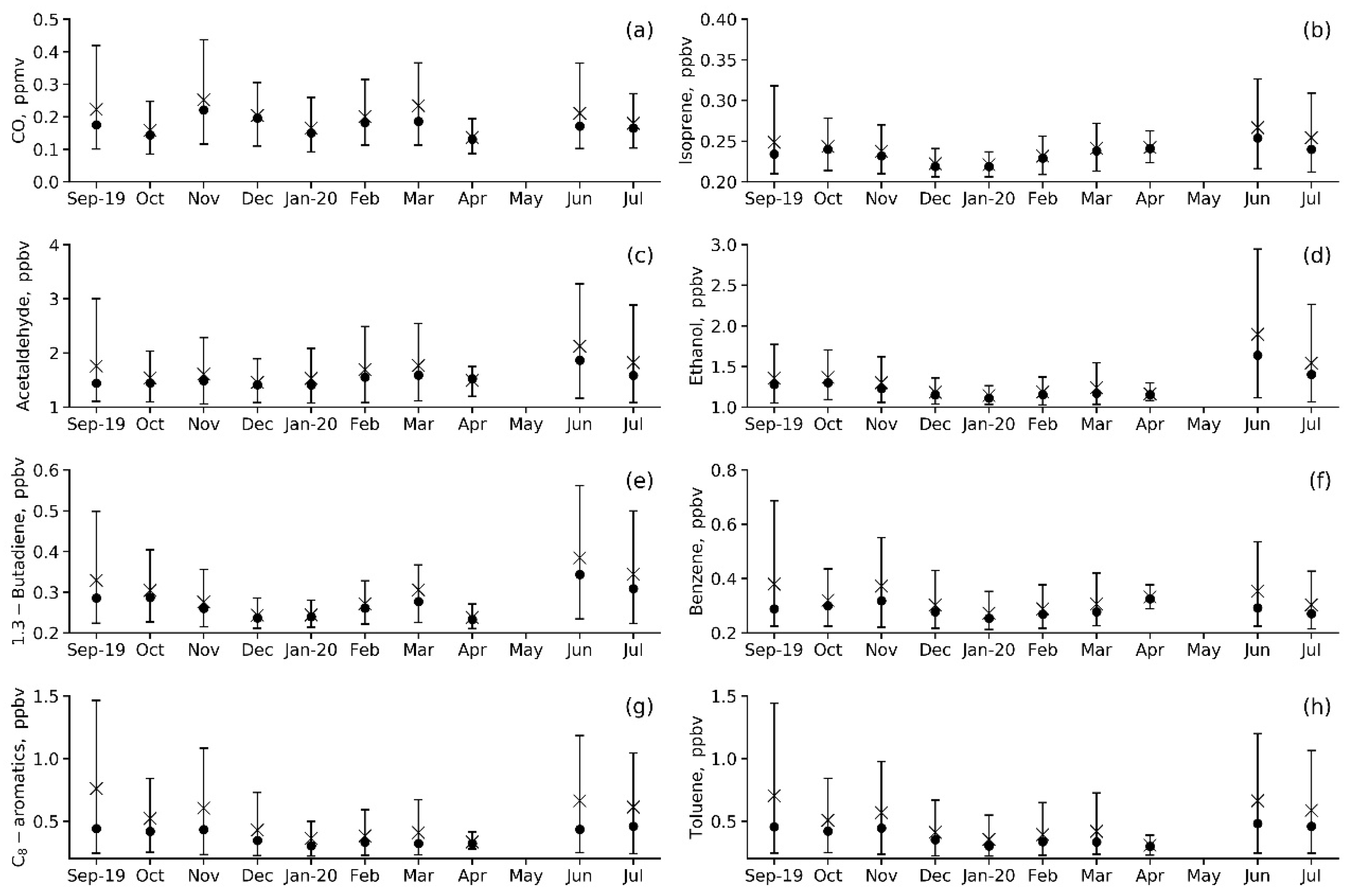
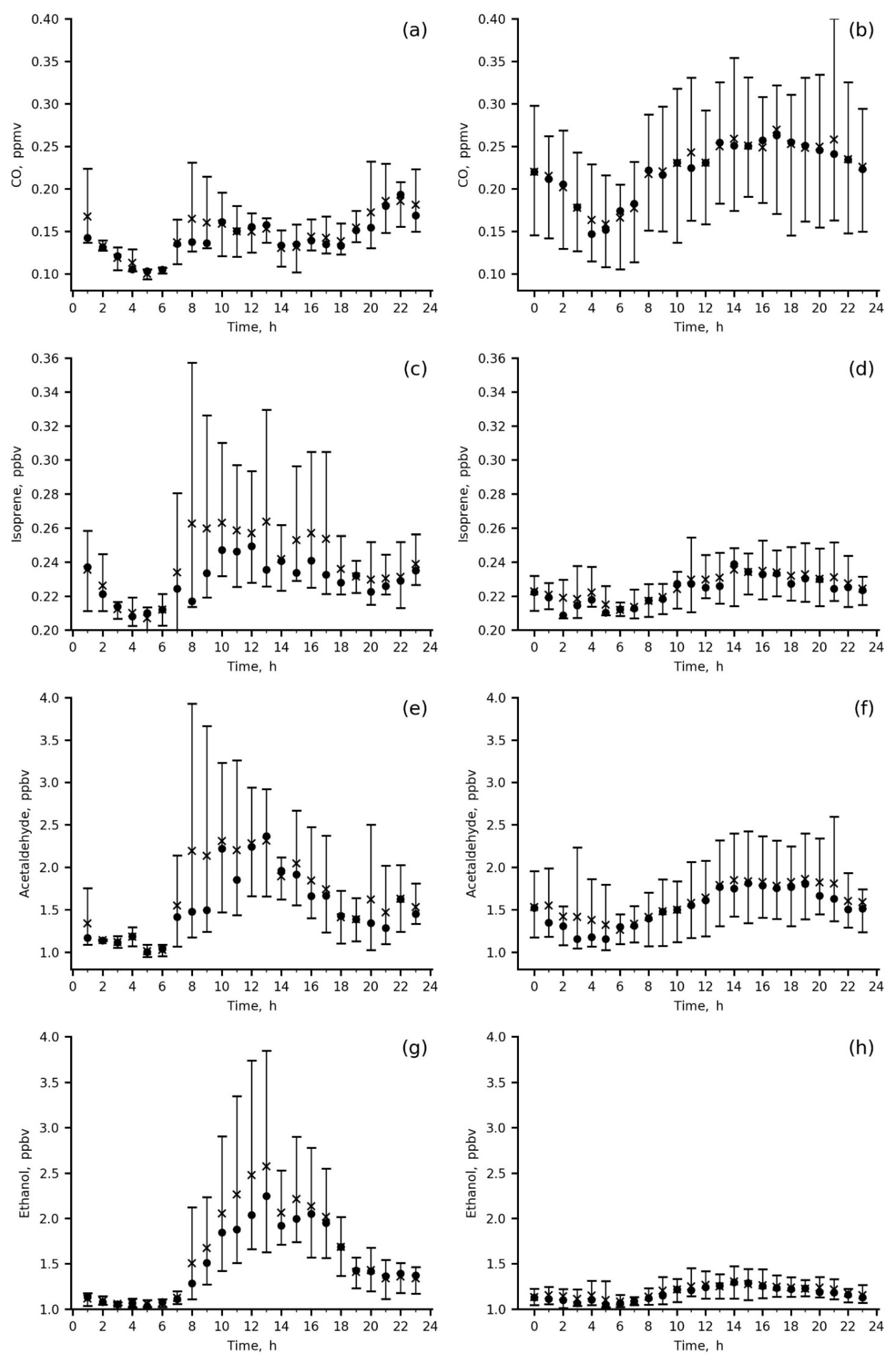

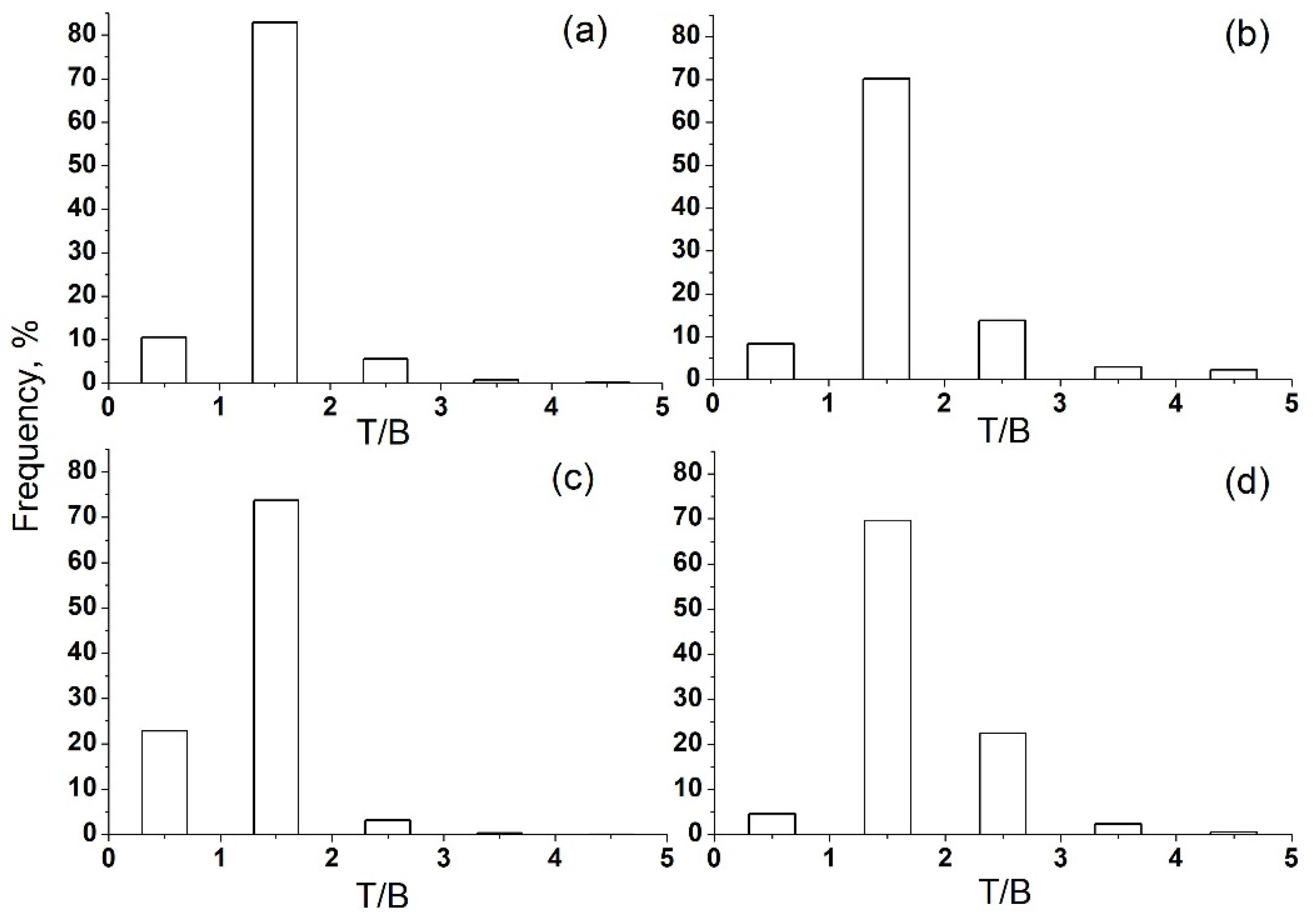
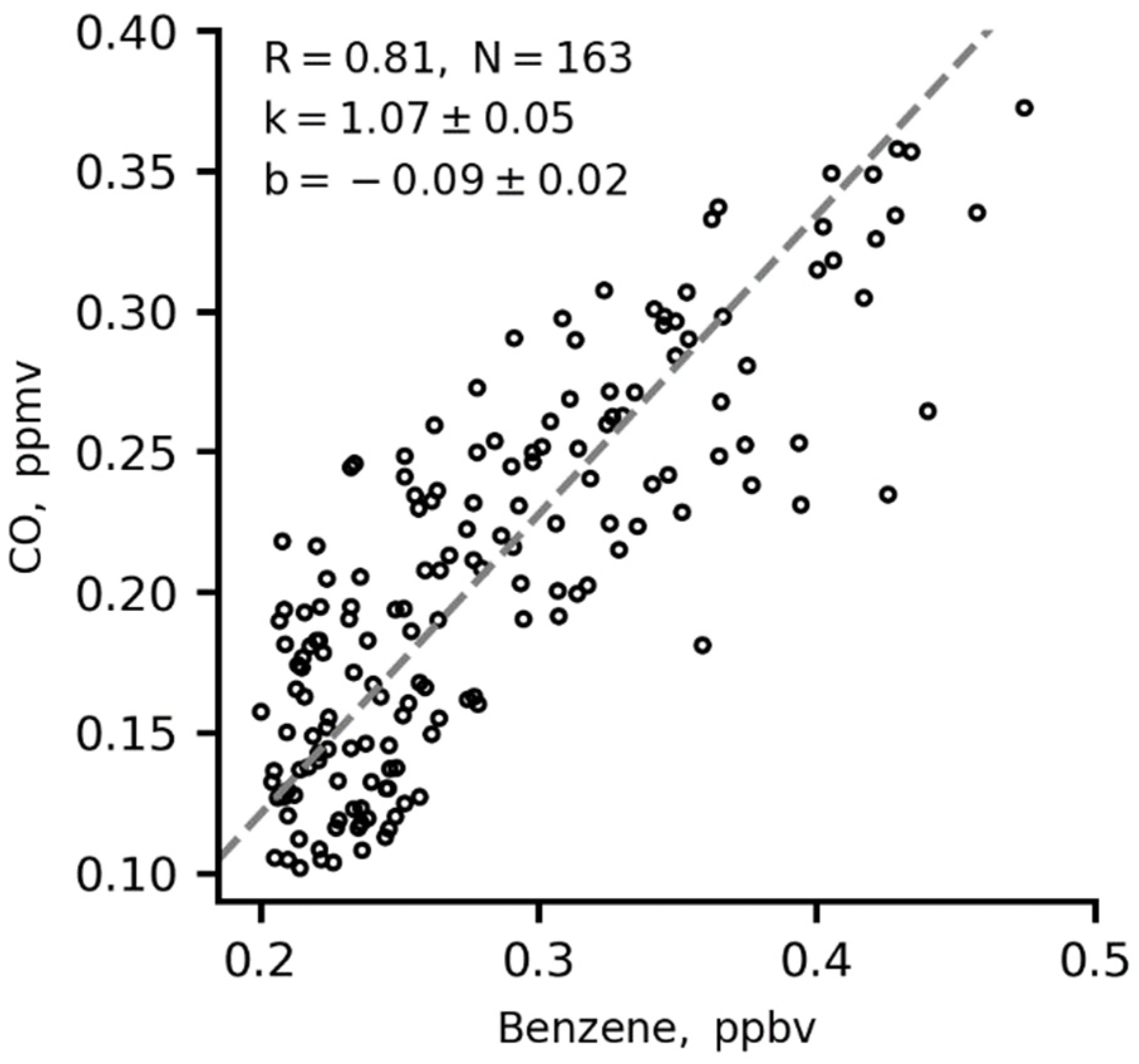
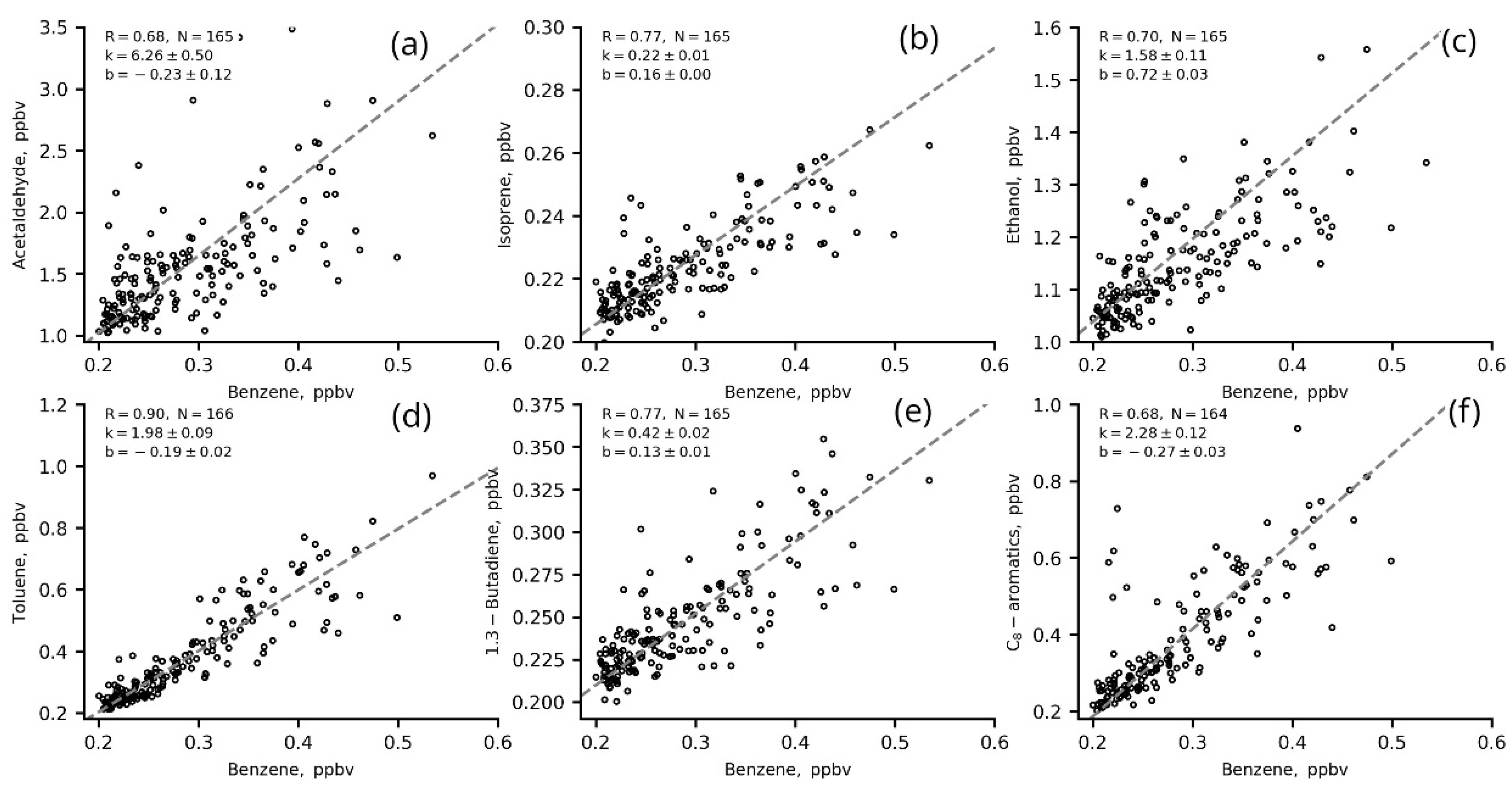


| VOC | ERbenzene (R) | ERCO (R) |
|---|---|---|
| Acetaldehyde | 6.26 (0.68) | 5.12 (0.59) |
| 1.3-Butadiene | 0.42 (0.77) | 0.33(0.64) |
| Isoprene | 0.22 (0.77) | 0.17 (0.67) |
| Ethanol | 1.58 (0.70) | 1.45 (0.63) |
| Toluene | 1.98(0.90) | 1.77(0.82) |
| C8 aromatics | 2.28 (0.68) | 1.74 (0.60) |
| Component | Emission Rate, ng/min | Emission Rate Accuracy, % | Working Temperature °C | Concentration at 1.0 l/min Air Flow, ppb | m/z |
|---|---|---|---|---|---|
| benzene | 78.0 | ±7 | 50 | 22.4 | 79.054 |
| toluene | 196.0 | ±7 | 50 | 47.8 | 93.070 |
| Isoprene | 366.96 | ±2.97 | 40 | 120.9 | 69.070 |
| α-pinene | 607.55 | ±1.75 | 40 | 100.1 | 81.070 137.129 |
| Month/Year | Air Temperature, °C | Wind Speed, m/s | Precip, mm | Snow Cover, cm | N Days | |||||||
|---|---|---|---|---|---|---|---|---|---|---|---|---|
| Mean | Mean min | Mean max | T min | T max | Mean | Gust | Month, mm | N days | Max | Rain | Snow | |
| 09/19 | +13.8 | +10.6 | +17.5 | +2.4 | +27.5 | 0.9 | 12 | 18 ↓ | 14 | |||
| 10/19 | +9.6 ↑ | +7.1 | +12.5 | −2.6 | +21.5 | 1.2 | 15 | 51 ↓ | 1 | 1 | 15 | 5 |
| 11/19 | +2.3 ↑ | +0.6 | +4.5 | −8.1 | +13.1 | 0.8 | 12 | 29 ↓ | 2 | 0.5 | 11 | 2 |
| 12/19 | +1.4↑ | 0.0 | +2.8 | −4.3 | +7.5 | 1.2 | 14 | 28 ↓ | 4 | 3 | 11 | 11 |
| 01/20 | +0.8↑ | −0.8 | +2.1 | −5.7 | +5.1 | 1.4 | 14 | 49 | 18 | 7 | 11 | 15 |
| 02/20 | +0.6↑ | −1.2 | +2.6 | −11.5 | +8.1 | 1.1 | 11 | 34 | 20 | 8 | 11 | 14 |
| 03/20 | +4.7↑ | +1.6 | +8.5 | −5.6 | +17.7 | 1.2 | 14 | 49↑ | 6 | 9 | 9 | 5 |
| 04/20 | +5.8 ↓ | +2.5 | +9.5 | −5.1 | +16.1 | 1.5 | 16 | 20 ↓ | 2 | 8 | 15 | 3 |
| 05/20 | +12.6 ↓ | +9.0 | +17.3 | +3.4 | +25.9 | 1.1 | 14 | 145 ↑ > 300% | 23 | |||
| 06/20 | +20.3 ↑ | +15.8 | +25.0 | +8.5 | +31.8 | 1 | 12 | 129 ↑ ~200% | 15 | |||
| 07/20 | +20.1 | +16.4 | +24.6 | +12.7 | +31.7 | 1 | 11 | 94 ↑ | 19 | |||
| VOC | m/z | Mean | σ | P10 | P90 |
|---|---|---|---|---|---|
| Acetaldehyde | 45.033 | 13.81 | 5.50 | 8.80 | 21.29 |
| Ethanol | 47.049 | 3.22 | 1.01 | 2.21 | 4.53 |
| 1.3-butadiene | 55.055 | 3.64 | 1.26 | 2.59 | 5.06 |
| Acetone | 59.049 | 0.56 | 0.55 | 0.20 | 1.09 |
| Acetic Acid | 61.028 | 0.96 | 0.74 | 0.30 | 1.97 |
| Isoprene+MBO | 69.070 | 1.91 | 0.34 | 1.63 | 2.37 |
| MVK+MACR | 71.086 | 1.41 | 0.42 | 1.00 | 2.08 |
| Benzene | 79.054 | 0.12 | 0.03 | 0.10 | 0.15 |
| MBO | 87.082 | 0.78 | 0.16 | 0.61 | 1.04 |
| Toluene | 93.070 | 1.13 | 1.10 | 0.51 | 1.91 |
| Phenol | 95.049 | 0.35 | 0.05 | 0.30 | 0.39 |
| Styrene | 105.070 | 0.19 | 0.02 | 0.17 | 0.21 |
| C8-aromatics | 107.086 | 1.87 | 2.38 | 0.85 | 2.90 |
| C9-aromatics | 121.102 | 0.93 | 0.31 | 0.70 | 1.22 |
| Monoterpenes | 81.070 137.129 | 0.37 | 0.05 | 0.32 | 0.43 |
| All VOCs | 31.26 | 9.90 | 22.47 | 44.28 |
| Compound | Mean | St. Dev. | Median | P10 | P90 |
|---|---|---|---|---|---|
| Autumn | |||||
| O3 | 9.26 | 8.41 | 8.00 | 0.40 | 20.40 |
| CO | 210 | 130 | 180 | 100 | 370 |
| Acetaldehyde | 1.63 | 0.65 | 1.46 | 1.08 | 2.29 |
| Ethanol | 1.34 | 0.29 | 1.27 | 1.07 | 1.70 |
| 1.3-Butadiene | 0.30 | 0.10 | 0.28 | 0.22 | 0.41 |
| Toluene | 0.59 | 0.52 | 0.44 | 0.24 | 1.03 |
| Isoprene | 0.24 | 0.03 | 0.24 | 0.21 | 0.28 |
| C8 aromatics | 0.62 | 0.77 | 0.43 | 0.24 | 1.04 |
| Winter | |||||
| O3 | - | - | - | - | - |
| CO | 190 | 080 | 170 | 100 | 300 |
| Acetaldehyde | 1.55 | 0.51 | 1.45 | 1.08 | 2.14 |
| Ethanol | 1.17 | 0.22 | 1.14 | 1.03 | 1.34 |
| 1.3-Butadiene | 0.25 | 0.05 | 0.24 | 0.21 | 0.30 |
| Toluene | 0.39 | 0.20 | 0.33 | 0.22 | 0.62 |
| Isoprene | 0.22 | 0.02 | 0.22 | 0.21 | 0.25 |
| C8 aromatics | 0.39 | 0.29 | 0.33 | 0.23 | 0.61 |
| Spring | |||||
| O3 | 18.11 | 10.96 | 18.30 | 3.00 | 32.80 |
| CO | 200 | 170 | 170 | 100 | 310 |
| Acetaldehyde | 1.76 | 0.63 | 1.58 | 1.12 | 2.53 |
| Ethanol | 1.24 | 0.23 | 1.17 | 1.04 | 1.54 |
| 1.3-Butadiene | 0.45 | 0.38 | 0.33 | 0.23 | 0.81 |
| Toluene | 0.25 | 0.04 | 0.24 | 0.21 | 0.29 |
| Isoprene | 0.41 | 0.30 | 0.32 | 0.23 | 0.66 |
| C8 aromatics | 0.30 | 0.63 | 0.28 | 0.22 | 0.37 |
| Summer | |||||
| O3 | 20.50 | 13.86 | 18.50 | 3.50 | 39.50 |
| CO | 190 | 110 | 170 | 100 | 310 |
| Acetaldehyde | 1.94 | 0.94 | 1.68 | 1.11 | 3.07 |
| Ethanol | 1.67 | 0.68 | 1.48 | 1.07 | 2.59 |
| 1.3-Butadiene | 0.36 | 0.15 | 0.32 | 0.23 | 0.52 |
| Toluene | 0.61 | 0.57 | 0.47 | 0.25 | 1.10 |
| Isoprene | 0.26 | 0.05 | 0.24 | 0.21 | 0.32 |
| C8 aromatics | 0.63 | 0.86 | 0.45 | 0.24 | 1.07 |
| VOC | ERbenzene (R) | ERCO (R) |
|---|---|---|
| Acetaldehyde | 6.26 (0.68) | 5.12 (0.59) |
| 1.3-Butadiene | 0.42 (0.77) | 0.33(0.64) |
| Isoprene | 0.22 (0.77) | 0.17 (0.67) |
| Ethanol | 1.58 (0.70) | 1.45 (0.63) |
| Toluene | 1.98(0.90) | 1.77(0.82) |
| C8 aromatics | 2.28 (0.68) | 1.74 (0.60) |
Publisher’s Note: MDPI stays neutral with regard to jurisdictional claims in published maps and institutional affiliations. |
© 2022 by the authors. Licensee MDPI, Basel, Switzerland. This article is an open access article distributed under the terms and conditions of the Creative Commons Attribution (CC BY) license (https://creativecommons.org/licenses/by/4.0/).
Share and Cite
Berezina, E.; Moiseenko, K.; Vasileva, A.; Pankratova, N.; Skorokhod, A.; Belikov, I.; Belousov, V. Emission Ratios and Source Identification of VOCs in Moscow in 2019–2020. Atmosphere 2022, 13, 257. https://doi.org/10.3390/atmos13020257
Berezina E, Moiseenko K, Vasileva A, Pankratova N, Skorokhod A, Belikov I, Belousov V. Emission Ratios and Source Identification of VOCs in Moscow in 2019–2020. Atmosphere. 2022; 13(2):257. https://doi.org/10.3390/atmos13020257
Chicago/Turabian StyleBerezina, Elena, Konstantin Moiseenko, Anastasia Vasileva, Natalia Pankratova, Andrey Skorokhod, Igor Belikov, and Valery Belousov. 2022. "Emission Ratios and Source Identification of VOCs in Moscow in 2019–2020" Atmosphere 13, no. 2: 257. https://doi.org/10.3390/atmos13020257
APA StyleBerezina, E., Moiseenko, K., Vasileva, A., Pankratova, N., Skorokhod, A., Belikov, I., & Belousov, V. (2022). Emission Ratios and Source Identification of VOCs in Moscow in 2019–2020. Atmosphere, 13(2), 257. https://doi.org/10.3390/atmos13020257








